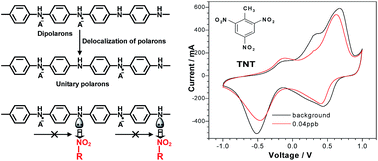A non-reductive electrochemical sensor for ultrasensitive detection of pM-level TNT†
Abstract
Most of the current electrochemical sensors for the detection of nitroaromatic explosives directly exploit the reduction of nitro groups at the electrode. In the case of trace analytes, a long pre-accumulation time to increase their adsorption at the modified electrodes is needed, and the sensitivity is greatly limited by the strength of redox signals of target species. The direct approach is particularly not suitable for analyzing weak/reductive trinitramine explosives. Herein, we report a non-reductive electrochemical sensor for the ultrasensitive real-time detection of pM-level trinitrotoluene (TNT). Ultratrace TNT can substantially prevent the reversible redox of PANI ultrathin layers at gold nanoparticles (AuNPs)/carbon nanotubes (CNTs) composite electrode, resulting in the decrease in oxidative peak currents of PANI. The voltammetric response is fast (almost immediate) and is greatly amplified by AuNPs. The detection limit for analyzing TNT is 4 ppt (18 pM). The limit of detection (LOD) and quantification (LOQ) of TNT was calculated to be 1.1 ppt and 3.7 ppt, respectively.

- This article is part of the themed collection: Analytical Methods Recent HOT articles


 Please wait while we load your content...
Please wait while we load your content...